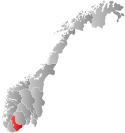Evje og Vegusdal
 From Wikipedia - Reading time: 7 min
From Wikipedia - Reading time: 7 min
Evje og Vegusdal Municipality
Evje og Vegusdal herred | |
|---|---|
 Evje Church cemetery and farm | |
 Aust-Agder within Norway | |
 Evje og Vegusdal within Aust-Agder | |
| Coordinates: 58°35′23″N 8°00′37″E / 58.5897°N 08.0104°E | |
| Country | Norway |
| County | Aust-Agder |
| District | Setesdal |
| Established | 1 Jan 1838 |
| • Created as | Formannskapsdistrikt |
| Disestablished | 1 Jan 1877 |
| • Succeeded by | Evje and Vegusdal municipalities |
| Administrative centre | Evje |
| Area (upon dissolution) | |
• Total | 510 km2 (200 sq mi) |
| Demonyms | Evdøl Veggdøl[1] |
| Time zone | UTC+01:00 (CET) |
| • Summer (DST) | UTC+02:00 (CEST) |
| ISO 3166 code | NO-0934[2] |
Evje og Vegusdal is a former municipality in the old Aust-Agder county in Norway. The 510-square-kilometre (200 sq mi)[3] municipality existed from 1838 until its dissolution in 1877. It was located in the Setesdal region in parts of the present-day municipalities of Evje og Hornnes and Birkenes. The administrative centre was the village of Evje where the Evje Church is located.
History
[edit]The parish of Evje og Vegusdal was established as a municipality on 1 January 1838 (see formannskapsdistrikt law). According to the 1835 census the municipality had a population of 1,627.[4] On 1 January 1877, Evje og Vegusdal was divided to create two separate municipalities: Evje with a population of 870 and Vegusdal with a population of 935. These two municipalities later became parts of Evje og Hornnes and Birkenes respectively.[5]
Name
[edit]The parishes of Evje and Vegusdal were merged in 1838 and the new, resulting municipality was given the compound name Evje og Vegusdal, literally meaning "Evje and Vegusdal".
The parish of Evje is named after the old Evje farm (Old Norse: Efja) since the first Evje Church was built there. The name is identical to the word efja which means "backwater" or "mud" (likely referring to a shallow, backwater part of the local river Otra).[6]
The parish of Vegusdal is named after the old Vegusdal farm (Old Norse: Veikolfsdalr) since the first Vegusdal Church was built there. The first element is derived from the old male name, Veikolfr. The male name itself was a compound name with the first component Veik- coming from veikr which means "weak" and the second component -olfr was a variant form of the more common male name Úlfr (also spelled Ulfr, from Old Norse úlfr, ulfr "wolf"; cf. Icelandic Úlfur and Faroese Úlvur). The last element of the name is dalr which means "valley" or "dale". Thus this is the "valley of Weak-Ulfr (or Weak-Wolf)".[7]
Government
[edit]During its existence, this municipality was governed by a municipal council of directly elected representatives. The mayor was indirectly elected by a vote of the municipal council.[8]
Mayors
[edit]The mayors (Norwegian: ordfører) of Evje og Vegusdal:[9][10]
- 1838-1839: Notto Jørgensen Tvedt
- 1839-1839: Baard Christensen Joreid
- 1840-1840: Dr. Bjelke
- 1840-1841: Gunder Salvesen Haugland
- 1842-1845: K.O. Knutzen
- 1846-1849: Gunstein Olsen Tvedt
- 1850-1855: Ole Evensen Kleveland
- 1856-1857: Jens Nicolai Egeberg
- 1857-1861: Ole Evensen Kleveland
- 1862-1863: Salve E. Bjoraa
- 1864-1865: Ole Evensen Dovland
- 1866-1866: Ole Gundersen Skrædderaas
- 1866-1870: Rev. Dietrichson
- 1870-1876: Salve E. Bjoraa
See also
[edit]References
[edit]- ^ "Navn på steder og personer: Innbyggjarnamn" (in Norwegian). Språkrådet.
- ^ Bolstad, Erik; Thorsnæs, Geir, eds. (26 January 2023). "Kommunenummer". Store norske leksikon (in Norwegian). Kunnskapsforlaget.
- ^ Kiær, Anders Nicolai; Helland, Amund; Vibe, Johan; Strøm, Boye (1904). Norges land og folk: Nedenes amt (in Norwegian). Norway: H. Aschehoug & Company. p. 368. Retrieved 19 December 2020.
- ^ Registreringssentral for historiske data. "Hjemmehørende folkemengde Aust-Agder 1801-1960" (in Norwegian). University of Tromsø. Archived from the original on 10 June 2007. Retrieved 14 October 2006.
- ^ Jukvam, Dag (1999). Historisk oversikt over endringer i kommune- og fylkesinndelingen (PDF) (in Norwegian). Statistisk sentralbyrå. ISBN 9788253746845.
- ^ Rygh, Oluf (1905). Norske gaardnavne: Nedenes amt (in Norwegian) (8 ed.). Kristiania, Norge: W. C. Fabritius & sønners bogtrikkeri. p. 193.
- ^ Rygh, Oluf (1905). Norske gaardnavne: Nedenes amt (in Norwegian) (8 ed.). Kristiania, Norge: W. C. Fabritius & sønners bogtrikkeri. p. 169.
- ^ Hansen, Tore; Vabo, Signy Irene, eds. (20 September 2022). "kommunestyre". Store norske leksikon (in Norwegian). Kunnskapsforlaget. Retrieved 1 January 2023.
- ^ "Ordførarar i Evje kommune". SetesdalsWiki.com (in Norwegian). Retrieved 21 July 2023.
- ^ Uleberg, Olav O.; Kleveland, Olav Arne (2003). Kultursoge for Evje og Hornnes (in Norwegian). Vol. II. Evje og Hornnes bygdeboknemd. pp. 264–365.
External links
[edit] Aust-Agder travel guide from Wikivoyage
Aust-Agder travel guide from Wikivoyage
 KSF
KSF